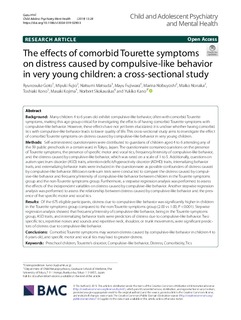| dc.contributor.author | Goto, Ryunosuke | |
| dc.contributor.author | Fujio, Miyuki | |
| dc.contributor.author | Matsuda, Natsumi | |
| dc.contributor.author | Fujiwara, Mayu | |
| dc.contributor.author | Nobuyoshi, Marina | |
| dc.contributor.author | Nonaka, Maiko | |
| dc.contributor.author | Kono, Toshiaki | |
| dc.contributor.author | Kojima, Masaki | |
| dc.contributor.author | Skokauskas, Norbert | |
| dc.contributor.author | Kano, Yukiko | |
| dc.date.accessioned | 2020-02-20T09:53:06Z | |
| dc.date.available | 2020-02-20T09:53:06Z | |
| dc.date.created | 2020-01-10T18:08:21Z | |
| dc.date.issued | 2019 | |
| dc.identifier.citation | Child and Adolescent Psychiatry and Mental Health (CAPMH). 2019, 13 (28), 1-7. | nb_NO |
| dc.identifier.issn | 1753-2000 | |
| dc.identifier.uri | http://hdl.handle.net/11250/2642820 | |
| dc.description.abstract | Background
Many children 4 to 6 years old exhibit compulsive-like behavior, often with comorbid Tourette symptoms, making this age group critical for investigating the effects of having comorbid Tourette symptoms with compulsive-like behavior. However, these effects have not yet been elucidated: it is unclear whether having comorbid tics with compulsive-like behavior leads to lower quality of life. This cross-sectional study aims to investigate the effect of comorbid Tourette symptoms on distress caused by compulsive-like behavior in very young children.
Methods
Self-administered questionnaires were distributed to guardians of children aged 4 to 6 attending any of the 59 public preschools in a certain ward in Tokyo, Japan. The questionnaire contained questions on the presence of Tourette symptoms, the presence of specific motor and vocal tics, frequency/intensity of compulsive-like behavior, and the distress caused by compulsive-like behavior, which was rated on a scale of 1 to 5. Additionally, questions on autism spectrum disorder (ASD) traits, attention-deficit/hyperactivity disorder (ADHD) traits, internalizing behavior traits, and externalizing behavior traits were included in the questionnaire as possible confounders of distress caused by compulsive-like behavior. Wilcoxon rank-sum tests were conducted to compare the distress caused by compulsive-like behavior and frequency/intensity of compulsive-like behavior between children in the Tourette symptoms group and the non-Tourette symptoms group. Furthermore, a stepwise regression analysis was performed to assess the effects of the independent variables on distress caused by compulsive-like behavior. Another stepwise regression analysis was performed to assess the relationship between distress caused by compulsive-like behavior and the presence of five specific motor and vocal tics.
Results
Of the 675 eligible participants, distress due to compulsive-like behavior was significantly higher in children in the Tourette symptoms group compared to the non-Tourette symptoms group (2.00 vs 1.00, P < 0.001). Stepwise regression analysis showed that frequency/intensity of compulsive-like behavior, being in the Tourette symptoms group, ASD traits, and internalizing behavior traits were predictors of distress due to compulsive-like behavior. Two specific tics, repetitive noises and sounds and repetitive neck, shoulder, or trunk movements, were significant predictors of distress due to compulsive-like behavior.
Conclusions
Comorbid Tourette symptoms may worsen distress caused by compulsive-like behavior in children 4 to 6 years old, and specific motor and vocal tics may lead to greater distress. | nb_NO |
| dc.language.iso | eng | nb_NO |
| dc.publisher | BioMed Central | nb_NO |
| dc.rights | Navngivelse 4.0 Internasjonal | * |
| dc.rights.uri | http://creativecommons.org/licenses/by/4.0/deed.no | * |
| dc.title | The effects of comorbid Tourette symptoms on distress caused by compulsive-like behavior in very young children: A cross-sectional study | nb_NO |
| dc.type | Journal article | nb_NO |
| dc.type | Peer reviewed | nb_NO |
| dc.description.version | publishedVersion | nb_NO |
| dc.source.pagenumber | 1-7 | nb_NO |
| dc.source.volume | 13 | nb_NO |
| dc.source.journal | Child and Adolescent Psychiatry and Mental Health (CAPMH) | nb_NO |
| dc.source.issue | 28 | nb_NO |
| dc.identifier.doi | 10.1186/s13034-019-0290-3 | |
| dc.identifier.cristin | 1770589 | |
| dc.description.localcode | Open Access This article is distributed under the terms of the Creative Commons Attribution 4.0 International License (http://creativecommons.org/licenses/by/4.0/), which permits unrestricted use, distribution, and reproduction in any medium, provided you give appropriate credit to the original author(s) and the source, provide a link to the Creative Commons license, and indicate if changes were made. The Creative Commons Public Domain Dedication waiver (http://creativecommons.org/publicdomain/zero/1.0/) applies to the data made available in this article, unless otherwise stated. | nb_NO |
| cristin.unitcode | 194,65,35,5 | |
| cristin.unitname | RKBU Midt-Norge - Regionalt kunnskapssenter for barn og unge - psykisk helse og barnevern | |
| cristin.ispublished | true | |
| cristin.fulltext | original | |
| cristin.qualitycode | 1 | |

